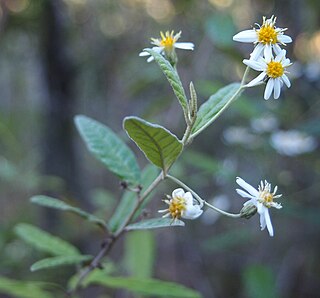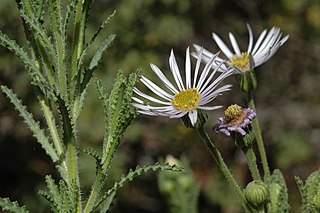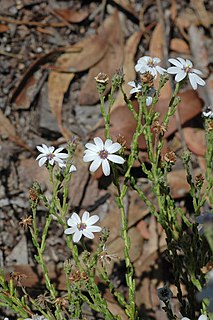
Olearia axillaris, commonly known as coastal daisy-bush, coast daisy-bush or coastal daisybush is a species of flowering plant in the family Asteraceae and is endemic to coastal areas of Australia. It is an erect, bushy shrub with densely cottony-hairy branchlets, aromatic, linear to narrowly elliptic or narrowly lance-shaped to egg-shaped leaves with the narrower end towards the base and small white and yellow, daisy-like inflorescences.

Olearia pimeleoides, commonly known as pimelea daisy-bush, is a species of flowering plant in the family Asteraceae and is endemic to southern continental Australia. It is an erect shrub with elliptic, linear or lance-shaped leaves, and white and pale yellow, daisy-like inflorescences.

Olearia canescens is a species of flowering plant in the family Asteraceae and is endemic to eastern Australia. It is a shrub with scattered elliptic or egg-shaped leaves, and white and yellow, daisy-like inflorescences.
Olearia burgessii is a species of flowering plant in the family Asteraceae and is endemic to south-eastern New South Wales. It is a shrub with scattered elliptic to egg-shaped leaves with the narrower end towards the base, and white and yellow, daisy-like inflorescences.
Olearia chrysophylla is a species of flowering plant in the family Asteraceae and is endemic to eastern Australia. It is a shrub with scattered elliptic leaves, and white and yellow, daisy-like inflorescences.
Olearia elaeophila is a species of flowering plant in the family Asteraceae and is endemic to the south-west of Western Australia. It is a small shrub with scattered linear leaves, and white or blue and yellow, daisy-like inflorescences.
Olearia fluvialis is a species of flowering plant in the family Asteraceae and is endemic to inland areas of northern Western Australia. It is a shrub with scattered, narrowly egg-shaped leaves, and white or mauve and yellow, daisy-like inflorescences.
Olearia gordonii is a species of flowering plant in the family Asteraceae and is endemic to inland southern Queensland. It is a small, erect, spreading shrub with linear leaves and blue, daisy-like inflorescences.

Olearia humilis is a species of flowering plant in the family Asteraceae and is endemic to the south-west of Western Australia. It is an erect, spindly shrub with narrowly egg-shaped or linear leaves, and purple and yellow, daisy-like inflorescences.
Olearia incana is a species of flowering plant in the family Asteraceae and is endemic to southern Australia. It is a shrub with narrowly elliptic or wedge-shaped leaves and white and pale yellow, daisy-like inflorescences.
Olearia incondita is a species of flowering plant in the family Asteraceae and is endemic to the south-west of Western Australia. It is a straggly shrub with narrowly elliptic leaves and white or pink and yellow, daisy-like inflorescences.

Olearia laciniifolia is a species of flowering plant in the family Asteraceae and is endemic to inland areas of the south-west of Western Australia. It is an erect shrub with scattered oblong leaves with small lobes on the edges, and lilac, white and yellow, daisy-like inflorescences.
Olearia lehmanniana is a species of flowering plant in the family Asteraceae and is endemic to inland areas of the south-west of Western Australia. It is a shrub with scattered elliptic or linear leaves that are densely hairy on the lower surface, and pale mauve, daisy-like inflorescences.

Olearia lepidophylla, commonly known as club-moss daisy-bush, is a species of flowering plant in the family Asteraceae and is endemic to southern Australia. It is a rigid, erect to spreading shrub with tiny oblong to egg-shaped leaves and white and yellow, daisy-like inflorescences.
Olearia mucronata is a species of flowering plant in the family Asteraceae and is endemic to inland areas of Western Australia. It is a densely-branched, unpleasantly aromatic shrub with crowded linear leaves, and white and yellow, daisy-like inflorescences.

Olearia muricata, commonly known as rough-leaved daisy bush, is a species of flowering plant in the family Asteraceae and is endemic to the south-west of Western Australia. It is an erect shrub with flat, linear to triangular leaves, and white or pale mauve and yellow, daisy-like inflorescences.
Olearia newbeyi is a species of flowering plant in the family Asteraceae and is endemic to the south-west of Western Australia. It is a shrub with broadly linear to narrowly oblong leaves, and dull purple, daisy-like inflorescences.
Olearia occidentissima is a species of flowering plant in the family Asteraceae and is endemic to the extreme west of Western Australia. It is an erect or prostrate, wind-pruned shrub with narrowly elliptic leaves that are woolly-hairy on the lower surface, and white, daisy-like inflorescences.
Olearia picridifolia, commonly known as rasp scrub-daisy, is a species of flowering plant in the family Asteraceae and is endemic to southern continental Australia. It is a low, spreading shrub with narrowly egg-shaped or narrowly elliptic leaves, and blue, mauve or white and yellow, daisy-like inflorescences.
Olearia plucheacea is a species of flowering plant in the family Asteraceae and is endemic to inland Western Australia. It is an erect, open shrub with scattered hairy, thread-like to linear leaves, and white and yellow daisy-like inflorescences.






